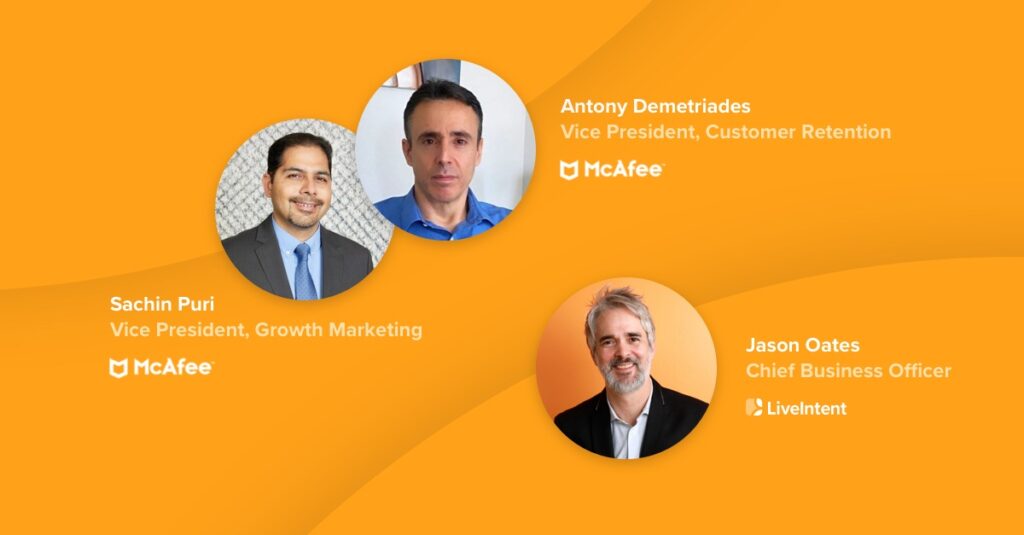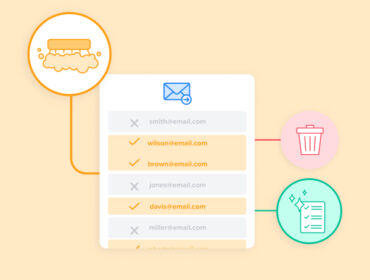Insider chat: How two McAfee marketers are thinking about personalization and a cookieless future
I really enjoyed the Brand Innovators fireside chat I moderated in September with Antony Demetriades, who heads customer retention at McAfee, a client of ours. In fact, I thought it would be great to continue our exchange and bring in another insightful voice, Sachin Puri, McAfee’s VP of growth marketing.

I was eager to focus on personalization and how they envision the path forward as third-party cookies fade away. They are marketers whose company safeguards customers from cyberattacks, so protecting privacy is more a mandate than a mere box to check.
Here are highlights of the conversation we had on the very day McAfee returned to Wall Street.
Oates: How do you personally think about personalization?
Demetriades: It’s really getting that intimate, personalized experience with our subscribers. It’s having a solid understanding of their desires, preferences, and behaviors, and then tailoring our offering to better meet their needs.
Puri: To me, it’s about being relevant to the customer at that moment in time, which adds value to the customer’s intent. That intent could be anything – like a desire to learn, transact, or read more.
Oates: I think a brand should be like a good friend who’s making solid recommendations in the moment as a human would.
Puri: I agree. It truly comes down to being helpful.
Oates: So personalization has to do with identifying where someone is in their journey and then being an aid to them in that moment. That’s super hard to do. What are the building blocks for providing good personalized advertising and marketing throughout the whole customer journey?
Puri: There are four pillars I’ve been using for the last few years. The first is audience. What do you know about the audience with the information you have, and hopefully in an aggregate and not in particular to account for personally identifiable information (PII)? The second element is what’s the content or creative you want to deliver when somebody is browsing through a newsfeed or social feed? What is relevant based on what we know about this customer who has been to our site? Maybe they read something about the security threat alert and are interested in learning more about security in their particular region. So the creative and content become extremely critical.
The third element is the delivery mechanism, which is what I put under technology. How do we make sure we deliver a relevant creative to an individual at the right time? A ton of companies in martech enable that, like LiveIntent, where you have the ability to recognize the customer and deliver a particular creative based on that particular audience that you are going after.
And then the last element is the data. Now, a lot of times, data is perceived more from the pure play, feeding into recognizing and managing the audience targeting and making it addressable. But I’ve also experienced that data is a very important element to measure what you’re doing is right and to do more of that. You can bring in artificial intelligence and machine learning. But at the end of the day, it always revolves around these four pillars in terms of go-to-market.
Oates: Where does McAfee net out in terms of starting to transition its use of identity as the third-party cookie gets phased out?
Puri: Customers have the power and control to define where and how they want to trade in their identity or information because identity and privacy is a right, and it has to be specifically opted in. We take privacy very seriously. It does make the job of a marketer difficult, for sure, but it also pushes us to go back to basics, to be helpful and relevant, and there are signals beyond always knowing something about a person. You don’t have to go to the person level. Cohorts are fairly explicit and informative for us to provide contextually relevant experiences.
In general, we do not engage in or with parties that use and leverage or sell customer data because we feel we have a pretty strong and substantial first-party database.
Oates: In terms of advertising, many people thought privacy regulations would improve the customer experience and overall marketplace. Instead, we’ve ended up in a Cookie Apocalypse; the death of the 3rd party cookie. That just makes Google, Facebook and Amazon even more powerful because they have so much first-party data and aren’t reliant on cookies. How might we improve privacy while sustaining a diverse and robust ecosystem of publishers and service providers?
Puri: In general I think improving privacy is a good initiative because it saves our customers from unwanted attacks or nefarious activities. Although, my personal view is it has to be done by a neutral party that supports the broader marketing ecosystem and is regulated by the government. The ability to create a unified ID is a good initiative, and I believe we will be able to use that ID across platforms. There has to be a very explicit opt-in from the customer – they can trade that information in exchange for some value or an agreed principle. We have to bring in neutrality in terms of who manages and owns the data of this ID. Right now, solutions are in the right direction, but they are done in silos. The silos don’t help our industry.
Demetriades: Having this governing body would obviously go a long way toward giving transparency. Not just that the data is being used, but also how it’s used, to what extent it is harvested, and for what reason. It will probably build some of the credibility back into the advertising industry.
Oates: I agree that unusual bedfellows are going to have to come together and be interoperable. If not, publishers face the potential of losing half their ad revenue in a cookieless world. I think this is the biggest problem the internet has faced since the bust in the early 2000s. Sometimes it takes an apocalypse to bring people together to think about the common good.


